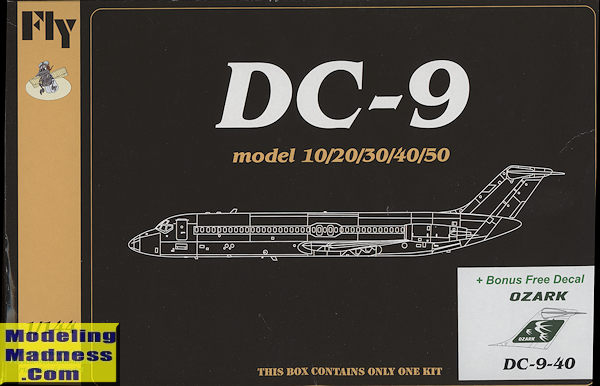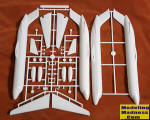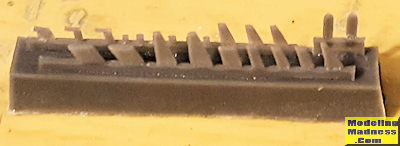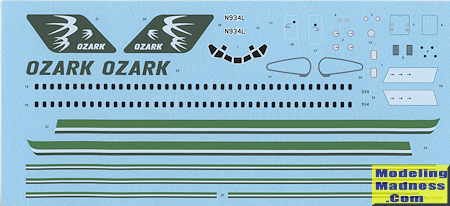
Fly 1/144 DC-9-40 (Ozark)
| KIT #: | 14424 |
| PRICE: | $35.95 SRP |
| DECALS: | One option |
| REVIEWER: | Scott Van Aken |
| NOTES: | Short run with resin parts |

| HISTORY |
On 1 September 1943 Ozark Air Lines was founded to fly services from Springfield, Missouri, and in January 1945 it began flights between Springfield and St. Louis on Beech 17 Staggerwings, replaced by Cessna AT-17 Bobcat in the late 1940s. The required license from the Civil Aeronautics Board was not forthcoming and operations had to stop.
In July 1950 Ozark was granted a certificate to operate Parks Air Transport routes not previously activated. Services were started on 26 September 1950 using Douglas DC-3s from St. Louis to Chicago, Tulsa and Memphis. In 1955 the airline had 13 DC-3s flying to 35 cities between Sioux City, Indianapolis, Wichita and Nashville. Ozark's main hub was Lambert–St. Louis International Airport. Like other Local Service airlines it was subsidized; in 1962 its operating "revenues" of $14.0 million included $4.5 million of federal subsidy.
In 1960 the fleet added turboprop Fairchild F-27s; Martin 4-0-4s were added in 1964.
Jets
In 1961 Ozark's network reached from Minneapolis to Nashville and from Kansas City to Indianapolis and Louisville. Denver was added in 1966 and in 1969 the network sprouted eastward: Ozark was awarded nonstops from Champaign and Peoria to Washington Dulles, continuing to New York LaGuardia. Atlanta was added in 1978 and four Florida cities in winter 1978-79.
By 1967 the Martins and F-27s were replaced with Fairchild Hiller FH-227s, a stretched F-27; the last DC-3 flight was October 1968. Ozark's first jets were Douglas DC-9-10s in July 1966. The DC-9-10s were augmented with DC-9-31/32 and DC-9-40s and Ozark went all-DC-9 in October 1978; in 1984 MD-82s were added. The three swallows on Ozark fins represented on-time flights, referring to the legend of the swallows that return to the Mission of San Juan Capistrano, in California, each year on the 19th of March.
Merger with TWA
In the mid-1980s Ozark and TWA had a de facto duopoly at Lambert–St. Louis International Airport, a hub for both. Ozark accounted for 26.3 percent of boardings at STL in 1985, while TWA accounted for 56.6 percent. On March 1, 1986 the two airlines announced plans to merge: TWA would buy Ozark for $242 million in cash. Shareholders of both airlines approved the merger by late summer, and the U.S. Department of Transportation gave its approval on September 12, 1986.
Ozark ceased to exist as an independent company on October 27, 1986. The Ozark DC-9s were gradually painted with a modified paint scheme with "TWA" in the tail. Over the next couple of years the fifty Ozark airplanes were repainted in the TWA livery.
The DC-9-40 is a further lengthened version of the Dc-9-30. With a 6 ft 6 in (2 m) longer fuselage, accommodation was up to 125 passengers. The Series 40 was fitted with Pratt & Whitney engines with thrust of 14,500 to 16,000 lbf (64 to 71 kN). A total of 71 were produced. The variant first entered service with Scandinavian Airlines System (SAS) in March 1968.
The DC-9 family of aircraft was one of the longest lived jet airliners being later developed into the MD-80, MD-90 and 717 series of aircraft. Production of all versions spanned from 1965 until 2006.
| THE KIT |
 Fly
has produced a series of DC-9s ranging from the short -10 to the rather long
-50, as you can see on the box. In fact, it seems that all of their boxings use
the same box and just place a sticker on it to show the variant and the livery.
I'm not sure why they say 'Bonus free decal' as there is only one set of decals
and I know of few buyers who would pay the sort of money Fly is asking just for
a plain white kit.
Fly
has produced a series of DC-9s ranging from the short -10 to the rather long
-50, as you can see on the box. In fact, it seems that all of their boxings use
the same box and just place a sticker on it to show the variant and the livery.
I'm not sure why they say 'Bonus free decal' as there is only one set of decals
and I know of few buyers who would pay the sort of money Fly is asking just for
a plain white kit.
This is, of course, not the only DC-9 done in this scale. There are several resin DC-9s out there as well as Airfix's venerable DC-9-30 that has been around for many decades. This kit is molded in white and has slick fuselage sides to accommodate the varying window arrangements. It does have engraved panel lines and a nicely molded windscreen which you can use to align the windscreen decal.
Apparently Fly provides a base DC-9-30 kit and simply adds in the additional fuselages to take care of the different dash numbers. As you can see, the slightly longer -40 fuselages are included with this one. The actual difference in length is about a half inch. Wings are upper and lower sections with the engines molded in two halves into which one places the first and last compressor stages. There are no locating areas for these. Engine pylons are molded on the fuselage and one simply attaches the engine pods to them via alignment pips.
 Holes
are drilled in the lower wings for the flap hinges and the lower wing spoiler.
Landing gear are supplied with separate gear legs and wheels. There is a
separate nose gear well, again, with no positive placement locators. Doors are
provided for the main gear so one could build this gear up, only needing to fill
in the opening for the nose gear leg. A resin sprue is provided for antennas.
Holes
are drilled in the lower wings for the flap hinges and the lower wing spoiler.
Landing gear are supplied with separate gear legs and wheels. There is a
separate nose gear well, again, with no positive placement locators. Doors are
provided for the main gear so one could build this gear up, only needing to fill
in the opening for the nose gear leg. A resin sprue is provided for antennas.
Instructions are apparently the same for all variations and do not show
the additional -40 fuselage. They do show -10 wing tips, but an e-mail to Fly
cleared up that those are only supplied with the -10 boxing. The markings are
for a single aircraft; N934L, which is a DC-9-41 so appropriate for this boxing.
They are4 very
 nicely done
and I note that there are decals to outline the large moveable panels attached
to the inside of the horizontal stabs so thy will need to be applied prior to
the stabs. This is the later Ozark livery and shows the aircraft prior to the
airline's takeover from TWA. The plane still flew on with TWA. Interestingly,
this plane was first registered in Japan, coming to Ozark in 1975. It was
striken off the records in 2005 when the airframe was cut up. It is the subject
of diecast models in both Ozark and TWA liveries.
nicely done
and I note that there are decals to outline the large moveable panels attached
to the inside of the horizontal stabs so thy will need to be applied prior to
the stabs. This is the later Ozark livery and shows the aircraft prior to the
airline's takeover from TWA. The plane still flew on with TWA. Interestingly,
this plane was first registered in Japan, coming to Ozark in 1975. It was
striken off the records in 2005 when the airframe was cut up. It is the subject
of diecast models in both Ozark and TWA liveries.
| CONCLUSIONS |
This is the first of these kits I've bought and I have to say that I think they are quite overpriced. While it is nice to have fresh decals and an engraved panel line DC-9, the fact that it is a short run detracts from that a bit. I guess the proof will be in the building as it is with all models.
| REFERENCES |
https://en.wikipedia.org/wiki/Ozark_Air_Lines
https://en.wikipedia.org/wiki/McDonnell_Douglas_DC-9#Variants
October 2016
Copyright ModelingMadness.com. All rights reserved.
Thanks to my billfold for the preview kit.
If you would like your product reviewed fairly and fairly quickly, please contact the editor or see other details in the Note to Contributors.